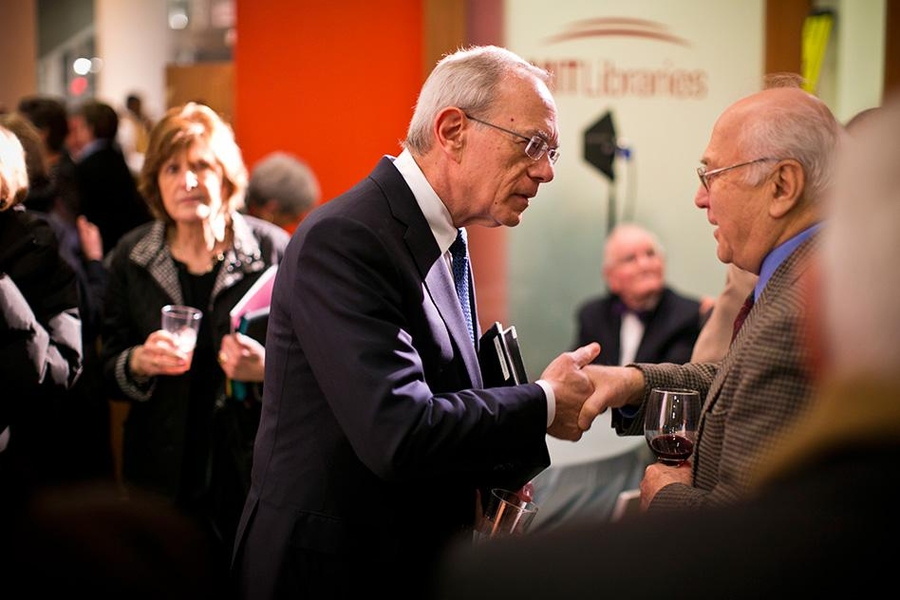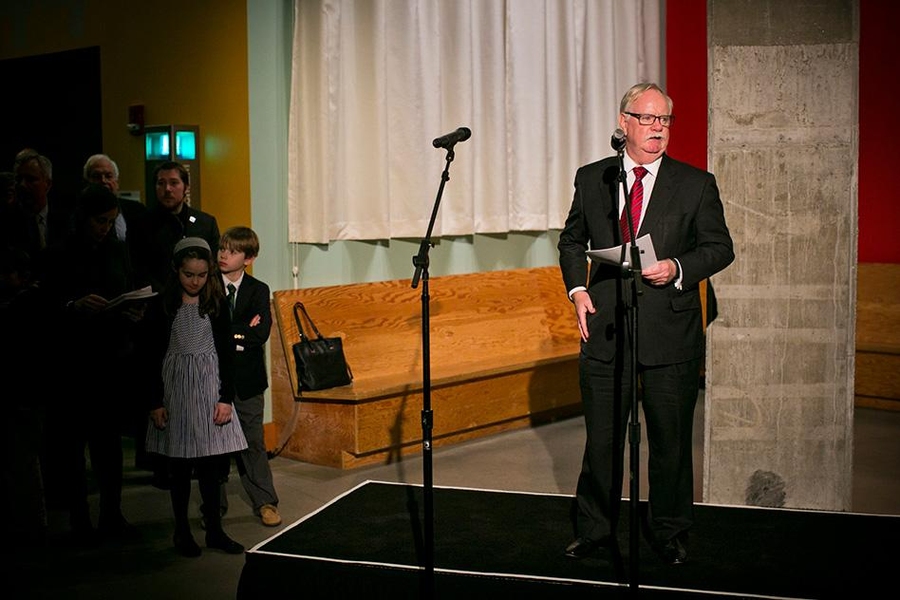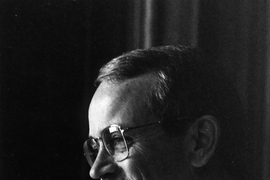The life of Charles Marstiller Vest — who insisted that everyone call him “Chuck” — was celebrated on Thursday by a throng of colleagues, friends, and family who packed Kresge Auditorium for a two-hour tribute to the highly respected and beloved former president. Vest died Dec. 12 after a battle with pancreatic cancer.
Vest, who served as MIT’s 15th president from 1990 to 2004, was the Institute’s third-longest-serving president, leading it through a time of great changes. Many of those who spoke at the gathering praised Vest for his exceptional combination of self-effacing modesty, good humor, and firm, steadfast principles.
“As you walk around the campus, his legacy is very much with us,” John Reed, chairman of the MIT Corporation, said in opening the gathering. Reed described Vest as “a person who was quiet but had firm beliefs, and they were grand beliefs” that “represented the values of MIT.”
MIT President L. Rafael Reif said, “I see Chuck now as a teacher, and I have become one of his most committed students.” He said that Vest was “so humble, modest, and unassuming that you did not notice his great intellect — at first.”
Eloquent actions
But upon reading a book of Vest’s essays, Reif said, “you see the full force and depth of his intellect. He was profoundly thoughtful, articulate, passionate, and clear — an impressive and formidable thinker. His words, wisdom, and vision stay with you. Yet what really takes your breath away, looking back over the distance of time, is the eloquence of his actions.” Those actions included Vest’s swift and decisive response to a 1999 report describing a pattern of unequal treatment of women on MIT’s faculty.
Nancy Hopkins, a professor emerita of biology who compiled that report, described herself as “someone whose life Chuck Vest changed. What’s astonishing is that Chuck achieved this feat with two sentences.”
Hopkins recalled that when Vest received the report, he quickly concluded — and declared publicly: “I have always believed that contemporary gender discrimination within universities is part reality and part perception. True, but I now understand that reality is by far the greater part of the balance.” He moved quickly to implement measures to address the problem — moves that were soon emulated by other universities.
Another decisive action by Vest was the implementation of MIT OpenCourseWare in 2002, making virtually all of the Institute’s curricular materials freely available to anyone in the world. Vest’s predecessor as president, Paul Gray, said yesterday, “Chuck believed that educational materials developed by universities should be shared,” adding that the impact of Vest’s decision has been “unmeasurable.”
Bold decisions
Those two acts, Reif said, were “bold decisions — non-obvious, non-trivial, historic. Decisions that — without marketing or fanfare — enabled quiet revolutions, here on our campus, across the country and around the world.”
Vest, Reif said, “shared our deepest values: excellence. Integrity. Meritocracy. Fairness. Openness. Humility, respect, and kindness. An instinct to always take the high road — and a commitment to making the world a better place.”
“Because the seeds and the foundation of Chuck’s decisions can be found in the rich soil of MIT values — and because they were bold — they have grown to inspire generations, probably beyond anything he could have anticipated,” Reif added.
Shirley Ann Jackson ’68, PhD ’73, president of Rensselaer Polytechnic Institute and a member of the MIT Corporation, described Vest, in a recorded appearance, as “self effacing and courageous,” a man who “led by letting others lead.” And former Vice President Al Gore, who also appeared on video, described Vest as “a true visionary” who saw MIT as “a place that could be a wellspring of innovation.”
Risks based on principles
After the gathering at Kresge, attendees moved across campus to one of the iconic buildings dating to Vest’s presidency: the Frank Gehry-designed Stata Center, whose first-floor common area, known previously as the “Student Street,” was renamed as the Charles M. Vest Student Street.
Robert Brown, who served as MIT’s provost under Vest and is now president of Boston University, recalled the decision to choose Gehry’s design — the “riskiest” of several choices for the building.Vest was “willing to take calculated risks based on principles,” Brown said. He believed that “MIT was about taking risks, in our education, in our research … and in our architecture.” Vest felt that MIT was “a beacon for science and technology around the world” — and that the bold design of the new building would serve to symbolize and enhance that reputation.
Vest’s two children — daughter Kemper and son John — also spoke at the Stata Center ceremony, at which a large portrait of their father was unveiled. “No family could be luckier, and no son could be prouder,” John Vest said.
Actions of MIT’s 15th president have ‘grown to inspire generations,’ Reif says.
Publication Date:
Press Contact:

Caption:
MIT President L. Rafael Reif greets guests at the dedication ceremony for the Charles M. Vest Student Street.
Credits:
<br />Photo: Dominick Reuter

Caption:
Speaking before the unveiling of a portrait of Vest at the Stata Center, Boston University president Bob Brown, who was MIT's provost under Vest, described the process that led to Vest's selection of Frank Gehry as the building's architect.
Credits:
<br />Photo: Dominick Reuter

Caption:
A portrait of President Charles M. Vest by artist Jon R. Friedman is unveiled at the Stata Center, as guests including Vest's son, daughter, widow, and grandchildren look on.
Credits:
<br />Photo: Dominick Reuter

Caption:
A new sign was illuminated at the dedication ceremony, designating the street-level public areas of the Stata Center as the Charles M. Vest Student Street.
Credits:
<br />Photo: Dominick Reuter
Related Topics
Related Articles






